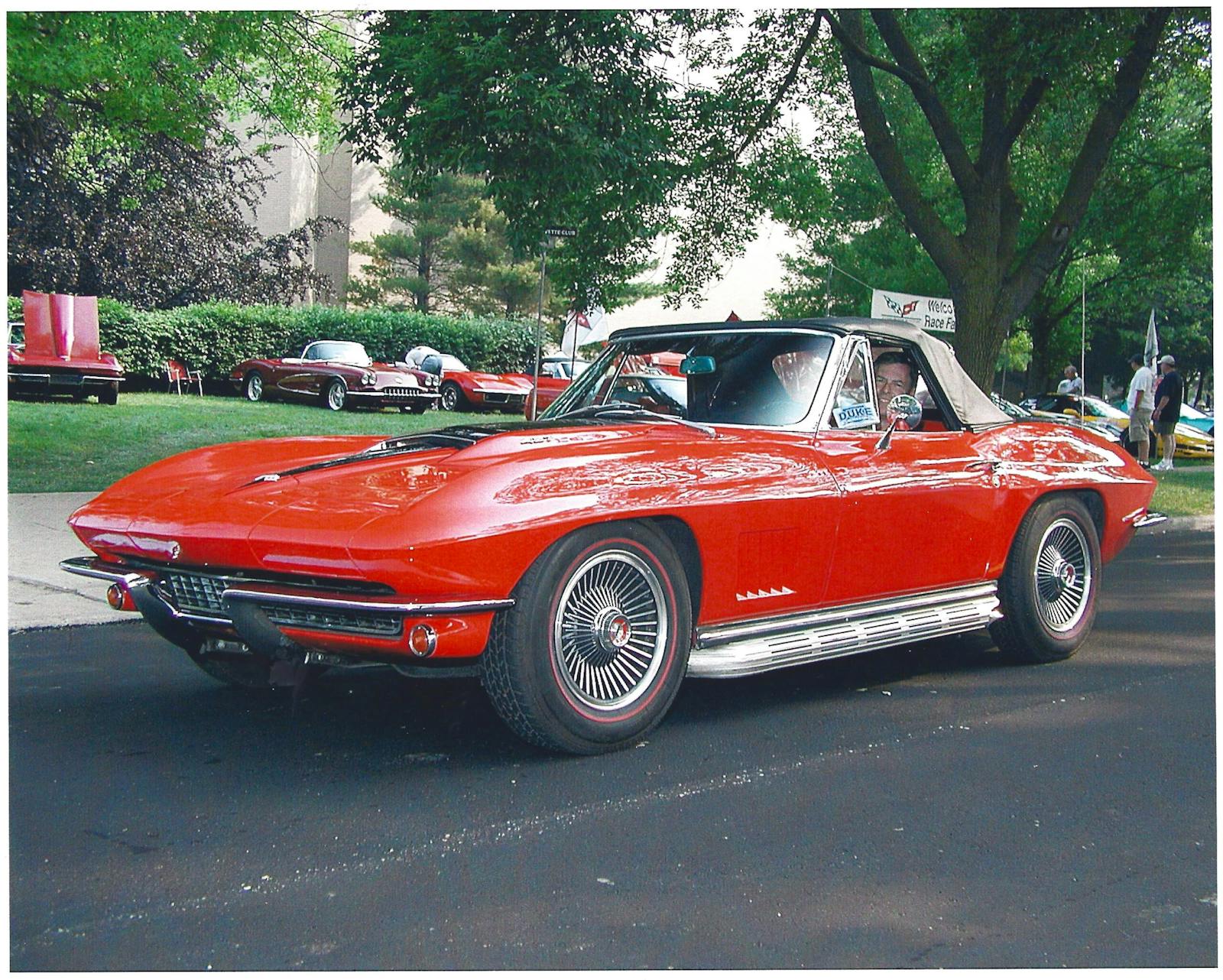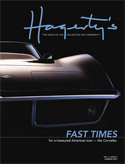The World of Corvette
That’s right. The Corvette has been around longer than the Bel Air, the Biscayne, the Malibu, the Chevette, the Corvair, the Camaro, the Nova, and even the Impala. A two-seat sports car from Chevrolet, one of America’s largest purveyors of family transportation? Who’d have thought?
But ever since that fateful day when America got an eyeful of a sexy windswept sports car at the New York Waldorf-Astoria ballroom at the 1953 General Motors Motorama, we’ve been hooked. More or less. Today, close to 1.4 million Corvettes have been produced, making it the world’s most popular sports car.
The Early Years
Offered originally with a straight-six engine, a two-speed automatic transmission and a solid-axle rear end, the Corvette didn’t inspire seasoned sports car people, even though it was a respectable performer for its day.
Supply and demand were also out of sync during those early years; the people who wanted to buy the car in 1953 couldn’t because Chevrolet put most of them into the hands of celebrities. The following year, few wanted the 3,640 roadsters built, a situation not helped by inconsistent body panel fit problems, and by 1955, production had slowed to 700 total cars, even though an optional V-8 was offered for the first time. Fortunately, Ford entered the fray with the Thunderbird that year and GM was not about to admit failure by backing out of the sports car market.
Corvette used racing to establish its credibility as a sports car. That crusade was led by chief engineer Zora Arkus-Duntov, who personified the early Corvette just as Enzo Ferrari or Ferry Porsche personified their marques. Duntov took the car to Sebring in 1956 and other racetracks in an effort to debunk the perception that European machinery was superior. But just as Duntov began to build momentum for a Corvette racing effort, GM withdrew from all factory racing programs.
So Duntov shifted his focus to helping independent race teams get the parts and technical assistance they needed to successfully race the car. His efforts included an option code known as RPO 684, which provided for special front and rear springs, heavier duty front stabilizer bar, metallic brake facings, finned brake drums and a quick-steering adaptor.
In the meantime, Duntov, working with John Dolza and others from the Rochester Products division, helped develop fuel injection, which upon its debut in 1957 produced one horsepower for every cubic inch of engine displacement – an industry first for a normally aspirated car.
All the while, those early solid-axle Corvettes were going faster – with small block displacement up to 327 cubic inches – and handling better thanks to Duntov’s constant tweaking of the suspension. By1962, the Corvette was a respected player.
The Sting Ray Years
But Duntov wanted more. While he would have preferred a midengine machine, he also knew that a new front-engine Corvette design based on Bill Mitchell’s Sting Ray racer was the inside favorite. It called for two body styles – the standard convertible and a new fastback coupe inspired by the 1936 Bugatti Type 57S Atlantic with a windsplit that ran from the nose of the car to the tail, interrupted only by the windshield.
For Duntov, an engineer/racer who prized functionality, the split window was a superfluous addon, hampering rear visibility. He went to war with Mitchell over the split and lost – with Chevrolet chief engineer Ed Cole ruling in Mitchell’s favor, at least for the first year. The conflict added to the mystique of the split window, limiting production to one model year (10,594 coupes) and elevating the collectibility of the first fixed-roof production Corvette. (Today, prices for show-quality split windows can range from $130K to as much as $260K for a Z06 model.)
Despite Duntov’s misgivings, the split window made everything around it – with the possible exception of an E-Type Jag – look 20 years older. It was one of the most stunning designs ever created. The second-generation Corvette was also noteworthy for its new ladder-style frame and an independent rear suspension that significantly elevated its road performance. The result was high demand in the showroom, with sales increasing by 33 percent over 1962.
While Chevrolet was still operating under GM’s no-factory-racing policy instituted in 1957, Duntov had in mind to offer cars his racing customers could buy to compete against Carroll Shelby’s Cobras, which were eating up the competition in Sports Car Club of America races. His first such effort was the Corvette Z06, which debuted at Riverside, California, in October 1962 and actually won its first race, but only because the faster Cobras suffered mishaps.
Duntov knew he had to come up with something more competitive than the Z06, so he developed plans for a special lightweight Corvette. His goal was to build 100 cars to satisfy the homologation requirements of the international sanctioning body, the FIA. Then he set about building five prototypes (some historians argue that six were actually built) that were more than 1,000 pounds lighter than a production Corvette. But GM management became aware of Duntov’s “end around” and shut down the project. Ever the risk-taker, Duntov defied orders by putting the five prototypes into the hands of various private race teams, with the culmination of the program being Nassau Speed Weeks in December 1963. There, the Grand Sports didn’t win overall, but managed to beat the Cobras, which was all that really mattered to Duntov. Chevrolet shut down the program for good after Nassau, and today those five original Grand Sports are in private hands. The Grand Sports are unquestionably the most valuable of all Corvettes – and don’t need the bright TV lights at Barrett-Jackson to quietly change hands for upward of $4 million dollars each.
Two years later, in 1965, Chevrolet added the first big-block to the Corvette lineup in the form of a 396 cubic-inch 425-hp engine with splayed valves nicknamed the “Porcupine Head.” That same year, four-wheel disc brakes became standard equipment.
The big-blocks proliferated, and by 1967, there were four different 427 cubic-inch engines available, ranging from the 390-hp L36 to the 435-hp L71 to the made-for-racing 430-hp L88, which actually put out far more horsepower than advertised. With only 20 L88s built for production cars in 1967, these cars are naturally quite valuable. The first production L88 recently went on the block at the RM Phoenix auction in January, and while the bidding went up to $1.5 million, it still didn’t meet the reserve price.
The Shark Years
The third-generation Corvette debuted in 1968, based on a Bill Mitchell shark-inspired show car, the Mako Shark II. It was originally supposed to debut in 1967, but Duntov managed to delay the car by a year to correct a visibility problem created by its high arching fenders.
The third generation also saw the debut of a powerful, solid-lifter small-block engine, the LT1, which put out a healthy 370 hp while costing an equally healthy $447.60 in 1970. By 1973, Corvette performance had peaked and the combined effects of a gas shortage and stricter emissions standards with the advent of unleaded gas served to curtail Corvette performance. By 1975, Corvette was down to two engine options – a 165-hp V-8 and a 205-hp V-8.
Duntov retired in 1975 and Dave McLellan took over as chief engineer. That year would be the last for a Corvette convertible until 1986.
Even with the performance decreases, Corvette production ramped ever upward. The 25th anniversary Corvette and Indy pace car from 1978 were both hot sellers, the latter causing a feeding frenzy at dealers, and by 1979, Corvette production reached an all-time high of 53,807 units. The third generation culminated with a Collector Edition Corvette in 1982.
The C4 and C5
The fourth generation Corvette debuted in 1983 as a 1984 model. It featured a clamshell hood showcasing an all-new chassis with a beautiful forged aluminum double-wishbone suspension that helped elevate its performance and inspired rave reviews from the motoring press. But while the suspension was capable of lateral acceleration up to 1g in Z51 guise, that capability came at the price of a harsh ride.
Shortly after the C4 debuted, rumors began to circulate about a new “King of the Hill” highperformance Corvette. The car would have a body that widened at the rear to accommodate huge rear tires and would be powered by Corvette’s first DOHC V-8, which was being developed jointly with Lotus. The engine would be manufactured at a special facility in Stillwater, Oklahoma.
The ZR-1, as it came to be called, was a superstar, capable of speeds exceeding 175 mph. Launched to the media in France, its performance electrified the motoring press, with the ZR-1 owning the cover of virtually every automotive publication in the world. But while sales were hot out the gate, they stalled rather quickly, thanks to its premium price – $58,995 – as well as concerns about long-term parts availability and serviceability for the Lotus-designed V-8. These factors contributed to a five-year lifespan for the car.
The fifth generation, or C5 Corvette, debuted in 1997 after much national angst over whether GM could even afford to build a new Corvette after several highly unprofitable years in the early 1990s. While the C5 was still under development in 1992, McLellan retired and Dave Hill took over as only the third Corvette chief engineer in the car’s history. Hill continued the McLellan theme of using a new central-tunnel architecture surrounded by a hydroformed steel frame. As a result, the C5 was more than three times stiffer than its predecessor, making it the most solid Corvette ever. It also enabled more advanced suspension tuning and resulted in a much more pleasing car.
The C5 was offered in coupe form in 1997 with a convertible added in 1998 and a fixed-roof coupe in 1999. The latter was to be a lower-cost, entry-level Corvette, nicknamed the “Billy Bob.” But Chevrolet backed way from the low-price concept and instead used the fixed-roof car as the platform for a new high-performance model called the Z06 in 2001. With 385 hp (later increased to 405), it provided ZR-1 performance for a fraction of the price.
Raising the Performance Bar
The first racing program for the Corvette since 1957 also began with the C5. Its goal was to win the production class (GT1) at the 24 Hours of Le Mans as well as the American Le Mans Series championship. Taking on competitors such as Viper, Ferrari, and later Aston Martin, the Pratt-Miller prepared Corvettes have won five times in seven tries at Le Mans and have garnered numerous ALMS championships.
The sixth-generation Corvette debuted in the 2005 model year and perfected the good things about the C5 while adding 400 standard hp and 400 lb.-ft. of torque. It also offered exposed headlamps for the first time since 1962. A new Z06 model was introduced in 2006 that contained a litany of racing technology, including the extensive use of carbon fiber, magnesium and an aluminum frame. With its 7.0-liter small block and dry-sump oiling system, the Z06 was capable of 505 hp and a top speed of 198 mph.
As good as the Z06 is, there are rumors of an even higher-performance Corvette in the pipeline, as well as a seventh-generation Corvette. Now under the guidance of vehicle line engineer Tom Wallace and chief engineer Tadge Juechter, Corvette’s role as a technological flagship for GM and Chevrolet appears safe.





